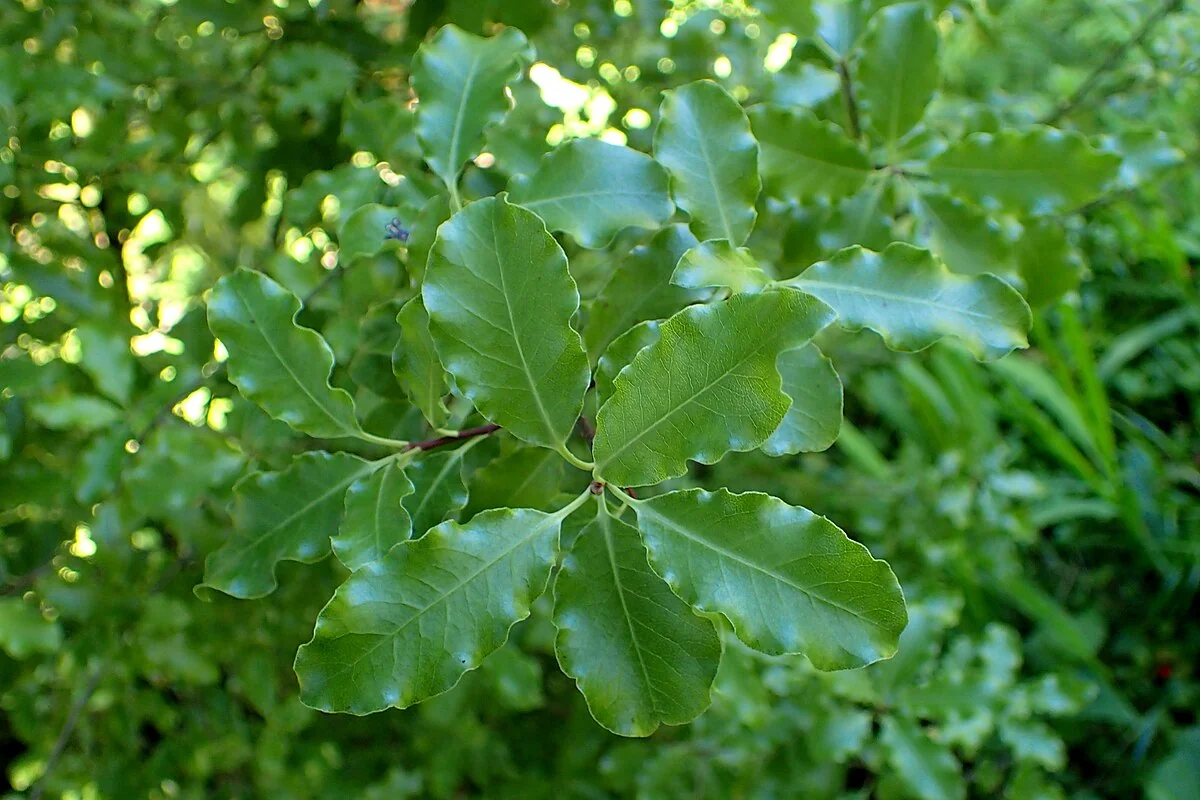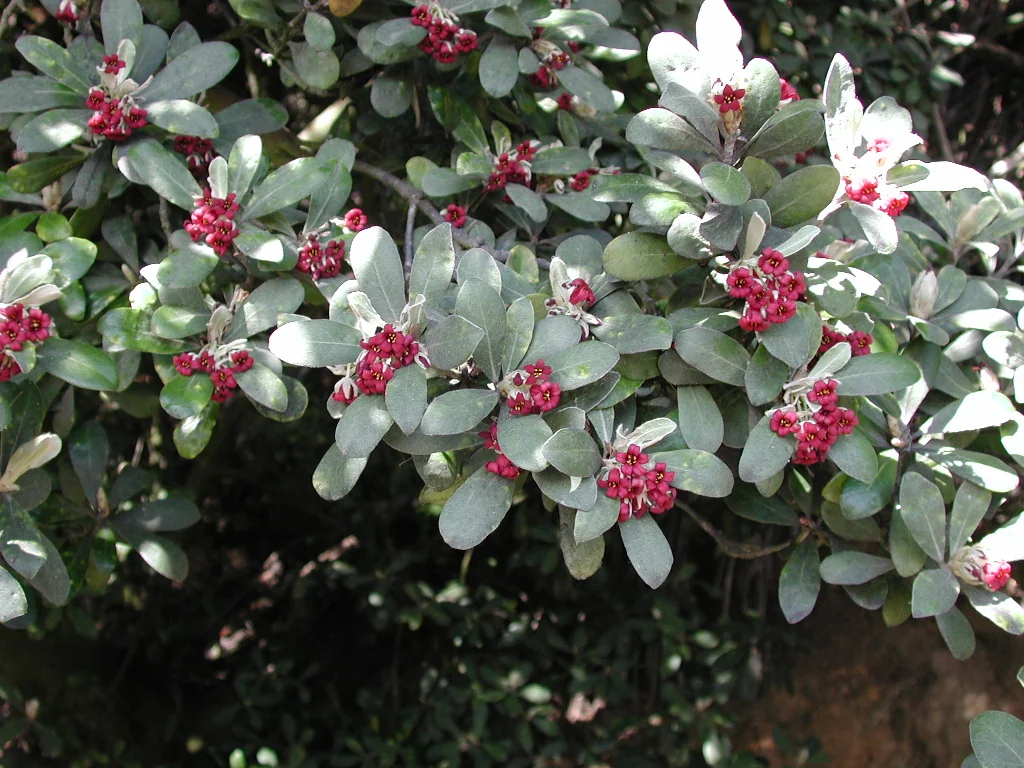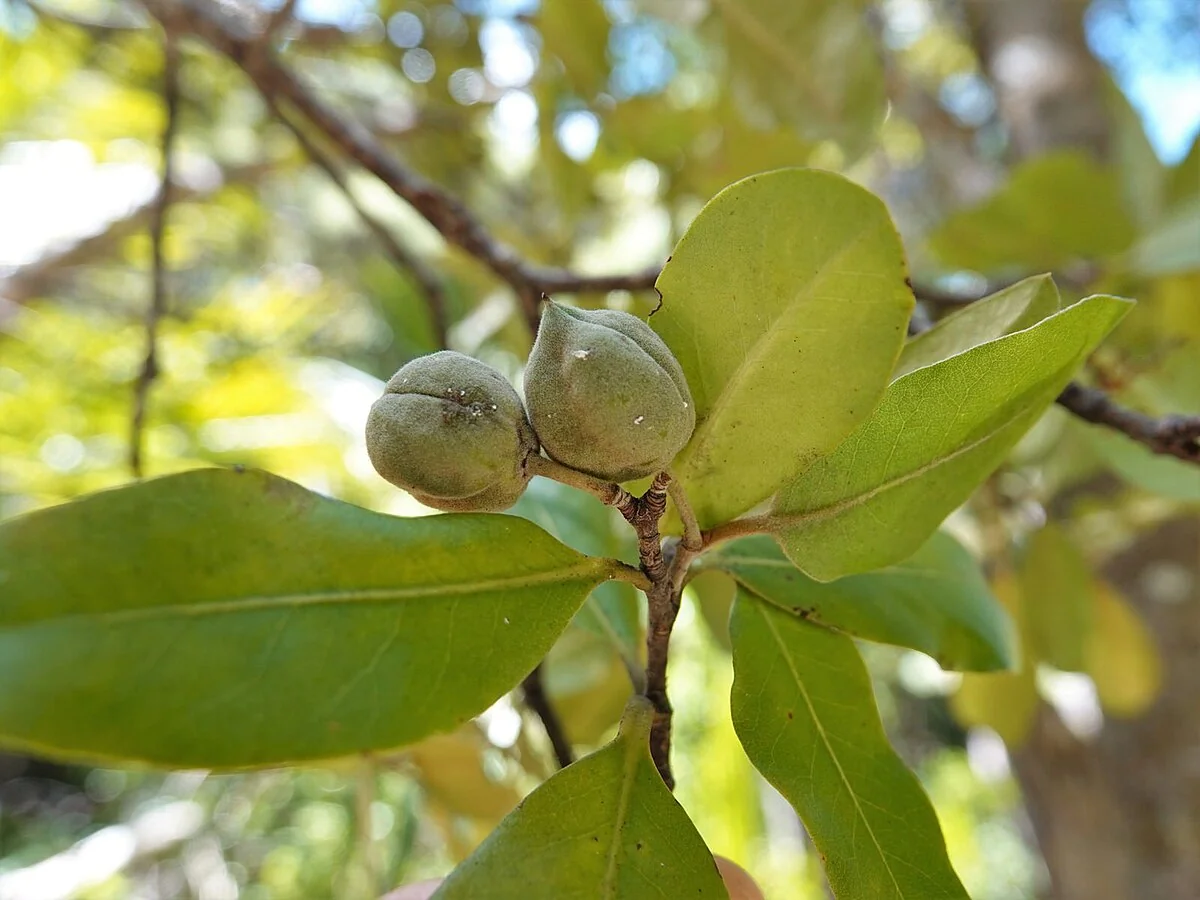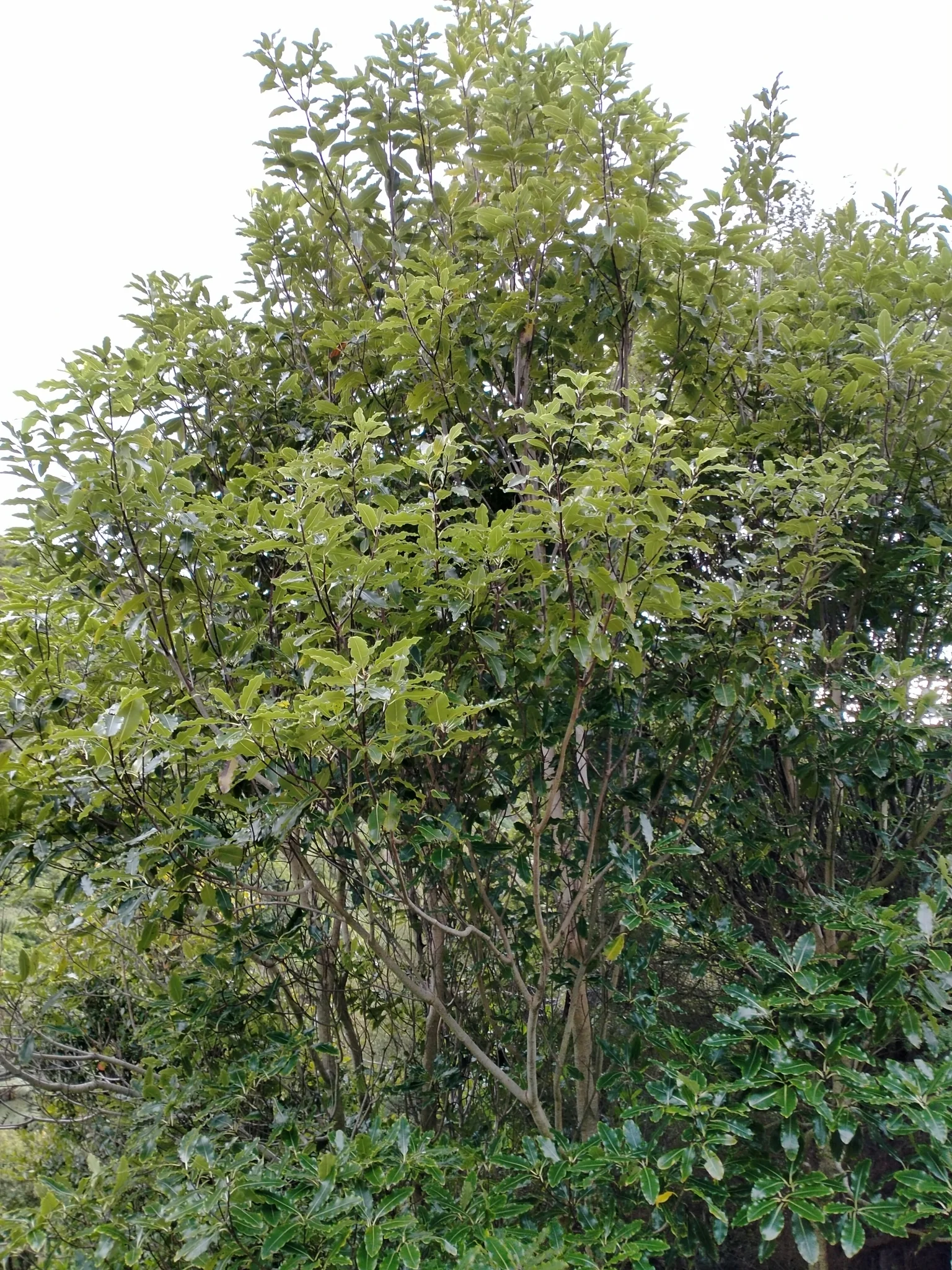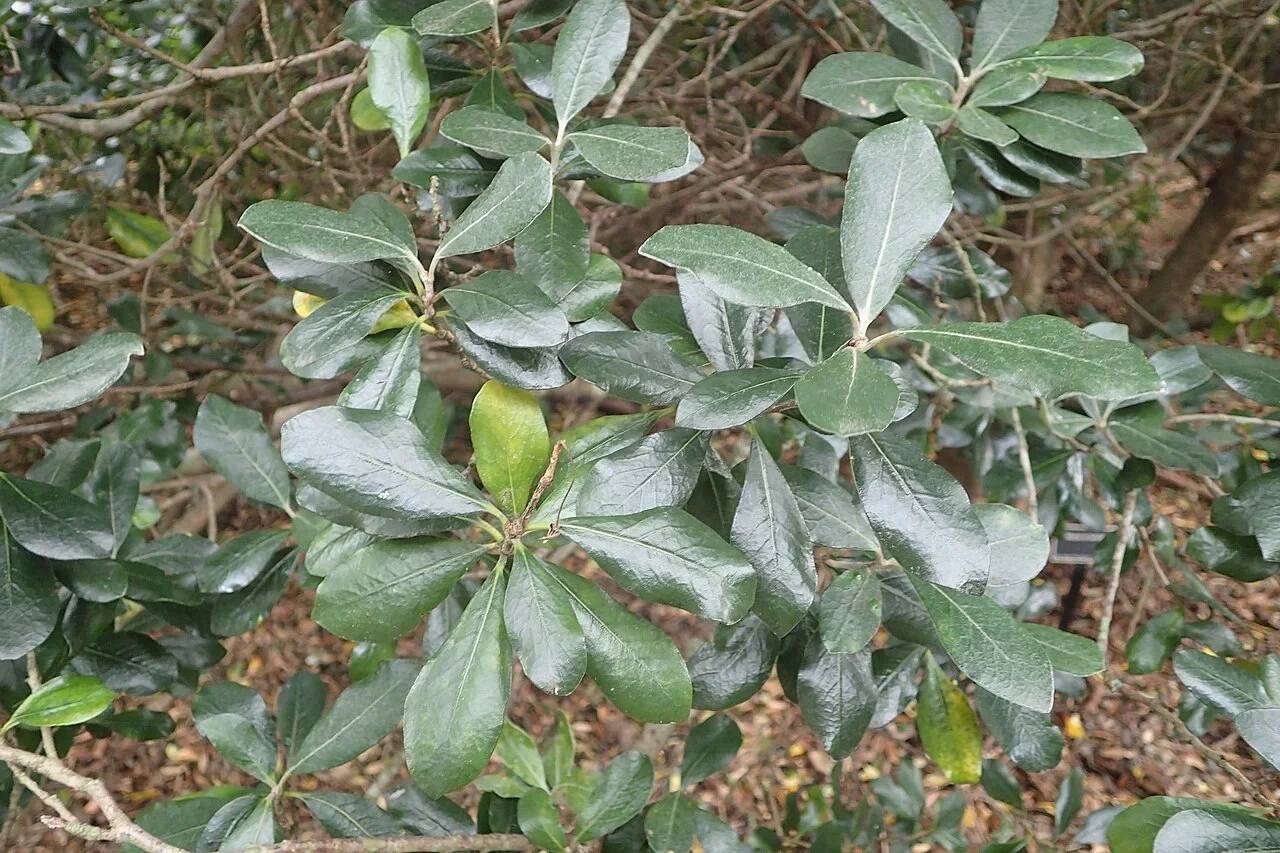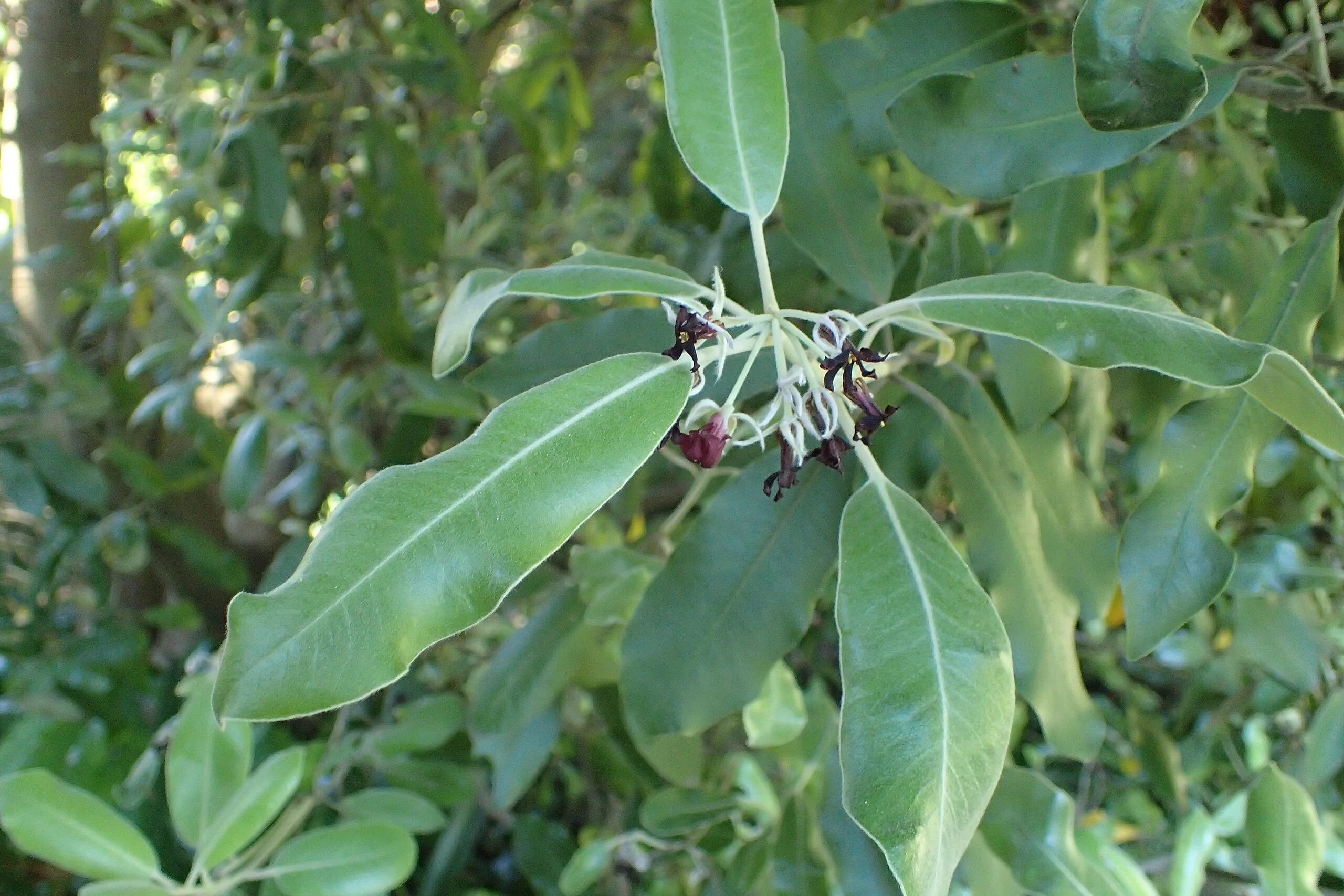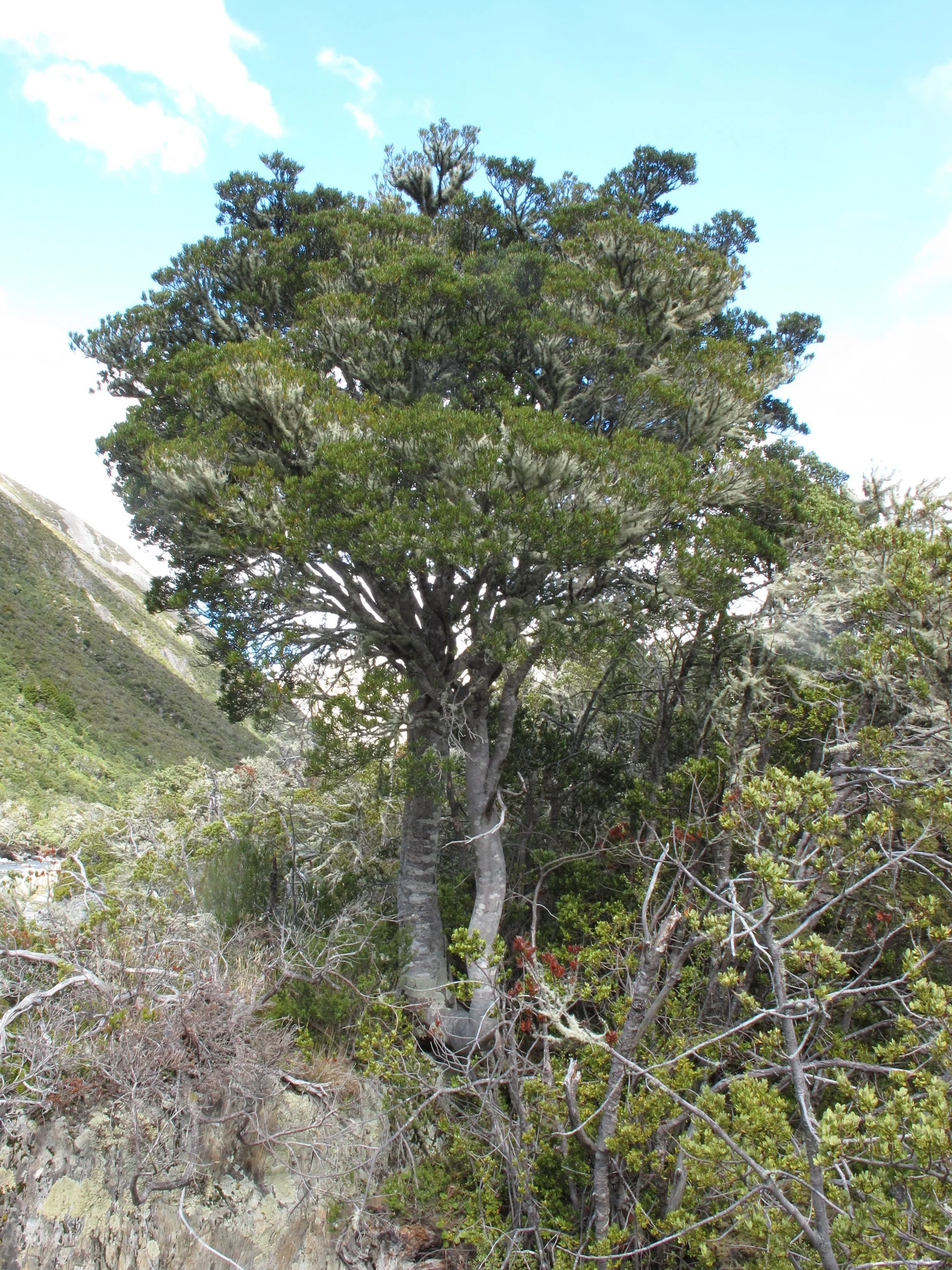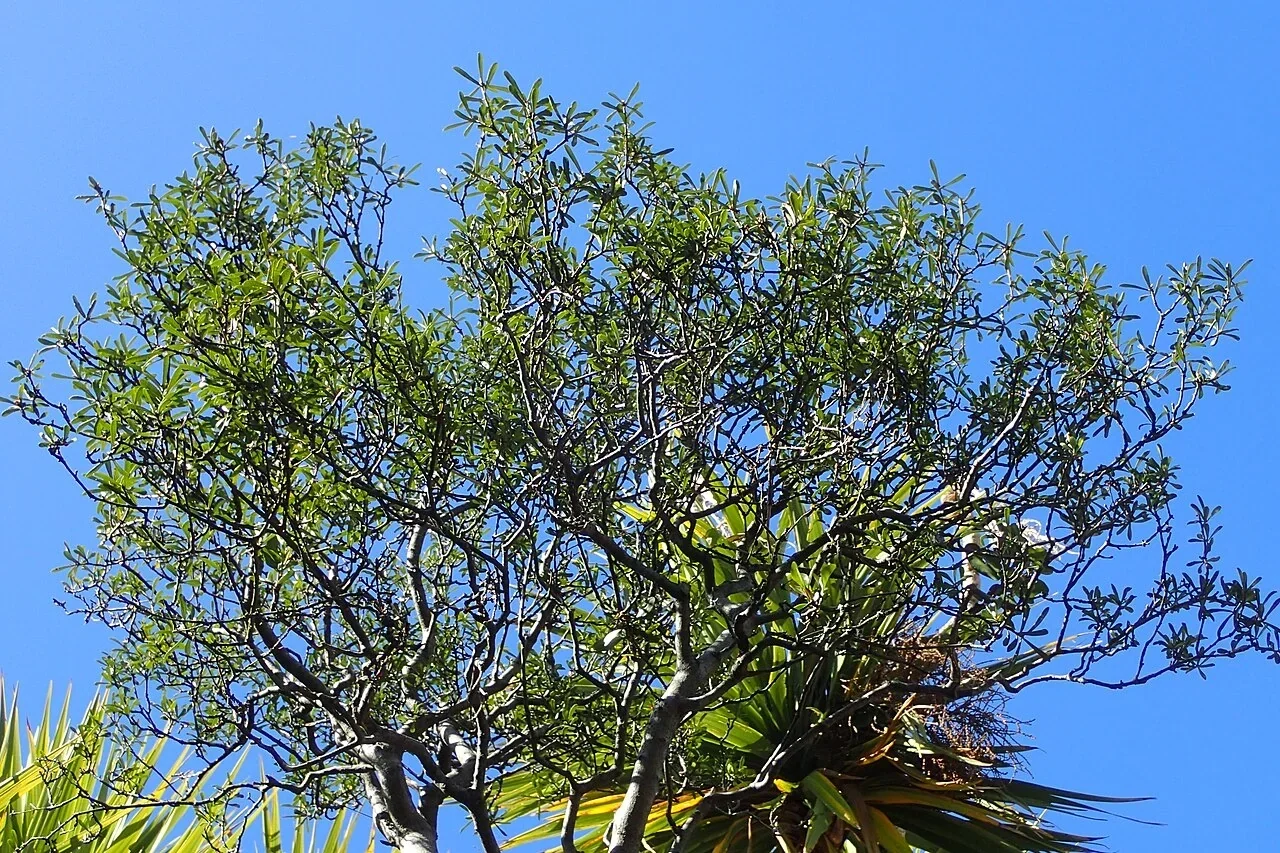
Turner's Kōhūhū
Pittosporum turneri
Graceful small tree with narrow, often wavy leaves; tolerant of a range of conditions with shelter. Learn more in our native plants guide .

Plant Description
Botanical Features
Turner's Kōhūhū ( Pittosporum turneri ), also known as the tent pole tree, is a rare small tree endemic to New Zealand, classified as Nationally Vulnerable. It is a small tree, growing up to 8 meters tall. It exhibits a distinct change in form as it matures. Young plants are cylindrical shrubs with dark grey bark and interlacing, zig-zagging branches. Adult trees develop a spreading canopy. Juvenile plants have small (0.5-2 cm long), oblong, glossy, leathery leaves of varying shape and colour. As the plant ages, the leaves become strap-like, longer (3-5 cm) and up to 1 cm wide, with smooth or slightly wavy margins. Adult leaves are coriaceous (leathery), 30-60 mm long and 5-10 mm wide, dark green, often flushed with red, and can be oblanceolate, obovate, or linear-lanceolate in shape. The plant produces small, fragrant flowers that bloom in clusters between October and December. The flowers are typically pink or red-pink, sometimes completely white, with five petals that recurve almost to the base. They are night-fragrant. The fruit is a subglobose capsule, 7-10 mm in diameter, which splits into two valves. The mucilage inside is dark red, and it contains 5-8 glossy black seeds.
Quick Facts
Overview
| Scientific Name | Pittosporum Turneri |
|---|---|
| Height | 4-8 m |
| Spread | 2-4 m |
| Light | Sun to partial shade |
| Water Needs | Moderate |
| Frost | Moderate; shelter young plants |
| Frost Tolerance | Moderate; protect from severe frosts |
| Salt Tolerance | Moderate; tolerates some coastal exposure |
| Growth Rate | Moderate |
| Lifespan | Long-lived |
Climate Best Suited to
Regional climate suitability across major New Zealand cities.
Regional Suitability
| City | Climate Suitability |
|---|---|
| Whangārei | Ideal |
| Auckland | Ideal |
| Hamilton | Ideal |
| Tauranga | Ideal |
| Rotorua | Ideal |
| Gisborne | Ideal |
| New Plymouth | Ideal |
| Napier | Ideal |
| Whanganui | Ideal |
| Palmerston North | Ideal |
| Wellington | Ideal |
| Nelson | Ideal |
| Christchurch | Ideal |
| Dunedin | Ideal |
| Invercargill | Ideal |
Natural Habitat
Turner's Kōhūhū ( Pittosporum turneri ), also known as the tent pole tree, is a rare small tree endemic to the central North Island of New Zealand. It is classified as Nationally Vulnerable, highlighting its restricted distribution and the importance of conservation efforts.
Preferred Conditions:
- Montane to Subalpine: It is typically found in montane to subalpine areas, growing at forest margins, frost flats, and in grey scrub alongside streams.
- Specific Distribution: Its distribution ranges from southern Pureora across the Volcanic Plateau to the northwest Ruahine Range.
Threats and Conservation:
- Habitat Loss: This species is considered threatened due to habitat modification and loss from land development or succession to tall forest.
- Browsing by Possums: It is highly susceptible to browsing by possums, which heavily consume its adult foliage, further endangering its populations.
- Lack of Seed Dispersal: Its fruit dispersal is affected by a lack of birds, impacting its ability to regenerate naturally.
- Weed Invasion: It is also vulnerable to weed invasion and habitat loss through natural succession as vegetation matures.
The unique ecological niche of Turner's Kōhūhū in these specific montane and subalpine environments underscores its importance in the biodiversity of New Zealand's central North Island. Its vulnerable status necessitates ongoing conservation efforts to protect its remaining populations and habitats.
Plant Conservation
Pittosporum turneri , also known as Turner's kōhūhū or the tent pole tree, is a species endemic to New Zealand and is currently classified as "Nationally Vulnerable." The International Union for Conservation of Nature (IUCN) Red List also listed it as "Conservation Dependent" in 1998.
Despite an estimated 30,000-50,000 plants in the wild, fewer than 400 are mature adult specimens, which significantly contributes to its vulnerable status.
Key threats to Pittosporum turneri Include:
- Possums: Adult foliage is a favorite food source for possums.
- Deer and Goats: Saplings are suspected to be eaten by deer and goats.
- Habitat Modification and Loss: This is due to land development for grazing and forestry, as well as natural succession where its habitat requires frequent disturbance to be maintained.
- Weed Invasion: Many sites are vulnerable to invasive weeds.
- Skewed Sex Ratios and Hybridism: Some populations exhibit skewed sex ratios or hybridize with other Pittosporum species, impacting reproductive success.
Growing Requirements
Soil
Well-drained, moderately fertile soils; avoid prolonged waterlogging.
Light
Performs in full sun to partial shade depending on species.
Water
Keep evenly moist while establishing; reduce irrigation as roots develop.
Temperature
Hardy in most regions of Aotearoa once established.
For Turner's Kōhūhū ( Pittosporum turneri ), choose a site with sun to partial shade and soil that is well-drained, moisture-retentive. Incorporate composted organic matter to improve structure and drainage. Plant with the crown or root collar at soil level, then apply a 5-8â¯cm mulch to moderate temperature, conserve moisture, and suppress weeds. Protect young plants from extremes while establishing and consider the stated frost tolerance (seasonal) when siting near exposure or cold air drains.
Planting Guide
Turner's Kōhūhū is a rare and nationally vulnerable native New Zealand tree, making its successful cultivation a valuable contribution to conservation efforts. While it has specific requirements due to its natural habitat, careful attention to these details will allow this unique and beautiful tree to thrive.
1. Site Selection:
- Light: Turner's Kōhūhū prefers full sun to partial shade. In its natural montane and subalpine habitats, it often grows at forest margins or in open areas, suggesting it appreciates good light levels. However, in very hot climates, some afternoon shade may be beneficial.
- Soil: It requires well-drained, moderately fertile soils. Its natural occurrence on frost flats and in grey scrub alongside streams indicates a preference for soils that are consistently moist but never waterlogged. Incorporating organic matter will improve soil structure and moisture retention.
- Shelter: This species is moderately frost-tolerant, but young plants, especially, will benefit from shelter from severe frosts and strong, salt-laden winds. Choose a site that offers some protection, particularly in colder regions.
2. Planting Instructions:
- Timing: The best time to plant is in spring or early autumn, allowing the plant to establish its root system before extreme weather conditions.
- Preparation: Dig a hole that is twice the width of the root ball and to the same depth. Gently remove the plant from its container, minimizing root disturbance.
- Placement: Plant at the same level as it was in the container. Backfill the hole with soil, gently firming it around the roots to remove air pockets.
- Watering: Water thoroughly immediately after planting to settle the soil.
- Spacing: For specimen trees, allow at least 2-4 meters for its mature spread. If planting in groups for restoration, adjust spacing accordingly.
3. Ongoing Care:
- Watering: Maintain consistent moisture during establishment, especially in the first two growing seasons. Once established, it is relatively drought-tolerant but benefits from regular watering during dry periods.
- Mulching: Apply a layer of organic mulch around the base of the plant to retain moisture, suppress weeds, and regulate soil temperature, keeping the mulch clear of the trunk.
- Fertilizing: A light application of a balanced, slow-release fertilizer in spring can support healthy growth, but avoid overfeeding, which can promote soft growth susceptible to wind damage.
- Pruning: Turner's Kōhūhū generally requires minimal pruning. Focus on removing dead or damaged branches and light shaping to maintain its natural form. Pruning is best done in late winter or early spring.
- Pest and Disease: Monitor for common pests like aphids or scale insects. Be particularly vigilant for possum browsing, as they heavily consume the adult foliage, posing a significant threat to this vulnerable species.
Ecosystem Notes
- Role: Evergreen mid-storey adding nectar, pollen, and shelter.
- Threats: Herbivory from possums; competition in mesic sites.
- Associates: Mixed broadleaf forest with Coprosma , Griselinia , and ferns.
Uses and Significance
Garden and Restoration
Graceful small tree with narrow, often wavy leaves; tolerant of a range of conditions with shelter.
- Small gardens and shelter
- Mixed native plantings
Raise Turner's Kōhūhū from seed collected when ripe, or by semi-hardwood cuttings set under intermittent mist. Use sharp, disease-free material and maintain moderate warmth and bright, indirect light for rooting.
Landscaping Ideas
Graceful Narrow-Leaved Form
- Specimen: Elegant small tree for sheltered courtyards and warm, frost-free gardens.
- Screening: Light clipping forms a fine-textured screen.
- Habitat plantings: Useful in native mixes where wildlife value is desired.
Seasonal Care Calendar
Spring
- Plant and mulch
- Protect new growth from weeds
Summer
- Deep watering in drought
- Monitor pests
Autumn
- Light formative pruning
- Top up mulch
Winter
- Plant eco-sourced stock
- Stake in windy sites
Pruning and Maintenance
Techniques and Timing
Generally minimal; formative work when young and removal of damaged wood.
Prune Turner's Kōhūhū lightly to maintain structure; remove damaged shoots and avoid hard cuts on older wood.
How to Grow Turner's Kōhūhū
Turner-s Kōhūhū ( Pittosporum turneri ) is best propagated from fresh, viable seed or from semi-hardwood cuttings taken from healthy, non-flowering shoots. Young plants establish fastest in free-draining soils with consistent moisture, light to moderate feeding, and shelter from severe frost and salt-laden winds.
From Seed
Collect ripe capsules in late summer to autumn when they split to reveal sticky, black seeds held in an orange resin. Clean seeds by gently removing the resin (a brief soak in lukewarm water helps) and sow promptly - fresh seed has the highest viability. Use a sterile, free-draining seed-raising mix and sow on the surface or with a very light cover of fine medium. Maintain steady moisture with a fine mister and keep trays in bright, indirect light at 18-22°C. Germination typically occurs in 3-8 weeks depending on temperature and seed freshness. Prick out seedlings at the first true-leaf stage into small pots, handling by the cotyledons to avoid root damage. Grow on in a sheltered position with good light and even moisture before hardening off for planting.
From Semi-Hardwood Cuttings
Take 7-10 cm semi-hardwood tip cuttings in late summer to early autumn from vigorous, non-flowering shoots. Remove the lower leaves, reduce large remaining leaves by half to limit transpiration, and make a clean cut just below a node. Dip the basal end in a general-purpose IBA rooting hormone (around 0.3-0.8% gel or 2,000-3,000 ppm powder) and insert into a free-draining propagation mix (e.g., 50-70% coarse perlite with fine bark or peat). Provide intermittent mist or a high-humidity propagator with bottom heat around 18-22°C and bright, filtered light. Keep the medium evenly moist but not waterlogged. Roots usually form in 6-10 weeks; pot on carefully once a firm root system has developed and acclimatise to lower humidity over 7-10 days.
Planting and Establishment
Choose a site with sun to light shade and well-drained soil improved with organic matter. Space plants to allow for a 2-4 m spread and provide shelter in exposed locations. Water regularly through the first two growing seasons, then reduce as roots establish. Apply a balanced, slow-release fertiliser in spring at label rates; avoid over-fertilising, which can cause soft, wind-prone growth. Mulch annually to conserve moisture and suppress weeds, keeping mulch clear of the stem. Prune lightly after flowering to maintain a tidy framework - remove dead, damaged or crossing branches and avoid severe heading cuts.
Pests and Diseases
Shelter and Drainage
- Browsing: Protect from possums and rabbits, especially when young.
- Scale/sooty mould: Treat with horticultural oil and improve canopy airflow.
- Root stress: Avoid waterlogging; plant on slight mounds in heavier soils.
Cultural Significance
Traditional Uses and Values
While Pittosporum turneri , also known as Turner's kōhūhū or the tent pole tree, is a rare New Zealand native tree, specific traditional uses are not widely documented. Today it is valued primarily in conservation plantings and restoration, especially where possum control is in place.
However, other species within the Pittosporum genus, such as Pittosporum eugenioides (tarata) and Pittosporum tenuifolium (kōhūhū), were culturally significant to Māori. Fragrant plants, including tarata, were sought after by Māori for use as scent or body lotion, with their resinous sap and crushed leaves mixed with plant oils. The kōhūhū (Pittosporum tenuifolium) is also noted for its noticeable scent at night during spring.
Pittosporum turneri is endemic to New Zealand's central North Island and is considered nationally vulnerable due to threats like possum browsing and habitat loss. It is a small tree that can grow up to 8 meters tall, with red-pink flowers that have a light scent in spring.
Bonus Tip
Expert Growing Advice
Despite there being an estimated 30,000-50,000 plants in the wild, fewer than 400 are adults, making this seemingly abundant species Nationally Vulnerable. This is largely due to possums, which heavily browse the adult foliage.
